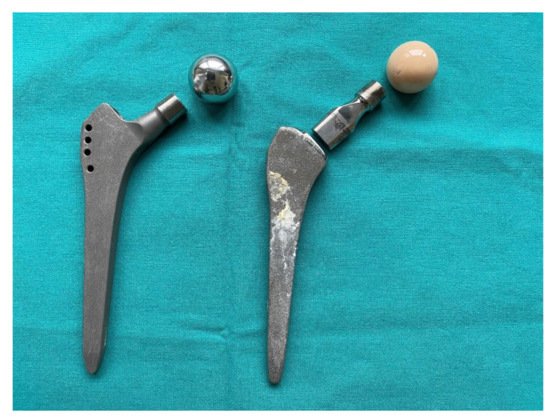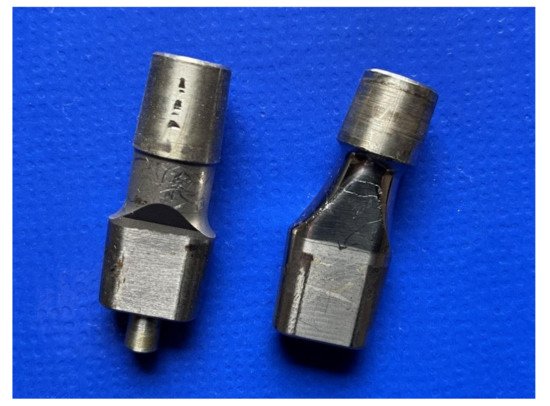4. Discussion
It is very hard to predict the lifespan of a particular implant. Studies concerning dual modular implants are not unanimous regarding implant survival rate. A nationwide study of 2767 hips has shown a time to fracture of 3.4 years (SD ± 1.4) for implants with a CoCr neck and 5 years (SD ± 2.3) for implants with Ti alloy necks
[21]. Even taking all known predisposing factors into account, it currently appears impossible to accurately pinpoint when a fracture is going to occur. A recent report for a patient with the same type of dual modular stem implanted on both hips described a modular neck fracture after 3 years on the left side and after 20 years on the right side post-implantation, respectively, with identical risk factors applying for both implants
[42].
Even though the mechanical loading of an implant can lead to crack initiation and propagation, it is not necessary for corrosion to take effect. The submersion of test bodies from four different frequently used alloys in serum has shown that 80% of the entire dissolution of ions happens in the first 24 h, but, more importantly, it happens without mechanical influences
[83]. When a crack is already formed past a certain point, there is no need for mechanical load for its propagation. Self-propagating autocatalytic processes occur that, selectively dissolve the beta phase of the alloy. A loss of alpha grains and their subsequent conversion into oxide follows
[13].
Acetabular cup deformation, an inevitable mechanical consequence in uncemented press-fit components, can lead to a breakdown in lubrication mechanisms resulting in suboptimal conditions
[84]. Furthermore, a large, thin-walled acetabular cup may be deformed by the deforming periacetabular bone when the hip is loaded. Consequently, it squeezes the large-diameter prosthetic heads, resulting in an increased frictional moment. The projection of the frictional moment onto the neck axis produces a torque on the neck which is transferred within the taper junctions, leading to greater corrosion-promoting micromotion
[85]. Binary logistic regression has shown that each 4-mm increase in head diameter increases the chance of neck fracture by a multiplicative factor of 3.21 for the Profemur Z and Profemur E hip systems
[18].
To minimize the impact of corrosion, we need to further explore the prevention of micromotion, the role of implant alloy metallurgy in the corrosion process, the in vivo generation of corrosive environment, and potential unanticipated problems
[86]. To protect alloys from corrosive processes, different coatings have shown some promise. A chitosan/diclofenac coating originally invented to achieve a more controlled and site-specific administration of a non-steroidal anti-inflammatory drug (NSAID) has shown an improvement in corrosion resistance for AISI 316LVM stainless steel
[87]. To achieve good long-term clinical outcomes, coatings should be thick enough to withstand the high contact stresses and they should avoid delamination
[88]; however, some coatings can be worn off to a macroscopically apparent degree with relative ease
[89], thus preventing their use on taper junctions. Currently, we are in most cases still relying on specific oxide-forming alloy properties in terms of uniform corrosion attack prevention.
Stability at the neck-stem junction can be significantly reduced if impaction during the assembly is not directed in line with the longitudinal axis of the taper junction, as occurs with 8° and 15° necks
[90]. Taper cleanliness also plays a very big role in preventing micromotion, as a comparative study has shown. In in vitro conditions, artificially contaminated taper junctions with porcine bone chips have created micromotions that are more than twice as large than those of clean taper junctions
[91]. Some relative motion at the neck-stem junction occurs due to the shape of the tapers deviating from an ideal design dimension
[92]. Three-dimensional contact colour maps clearly indicate that the surfaces are not in contact over the entire circumstances but typically at four localized lines of contact. Some implants also show one surface in contact or at closer proximity than the contralateral surface. The cause of the deviation in dimensions is most probably machine tool deflexion during machining
[92].
More rigorous and realistic preclinical testing should be done before new types of modular junctions are introduced in clinical practice
[93]. When surgeons start to use a new implant design, there should be a 5-year follow-up or, even better, 5-year post-market surveillance studies before introducing newer alternate bearings and/or junctions in THA on a widespread scale
[94]. Simulations of fretting corrosion under different conditions have shown that preclinical protocols should adopt testing implant in bovine calf serum and some studies have also suggested simultaneous testing at different pH levels
[95]. Immersion in bovine calf serum instead of Ringer’s solution significantly decreases the endurance limit of the taper junction
[96]. Our search method identified no studies that would expose the implant and the solution to an electric current simulating the galvanic processes as they occur in the body.
Taper corrosion leading to an ALTR can mimic other more common diagnoses, like instability, aseptic loosening, or periprosthetic joint infection
[97]. Serum metal ion levels are currently the best screening tool for corrosion
[97]; however, they should never be used as a sole investigative tool, but rather as a part of a more complete clinical and radiographic evaluation
[98]. Furthermore, they do not correspond with the other factors for modular neck fracture very well, making them an inefficient tool in screening patients with dual modular implants for upcoming modular neck fracture, especially in TiTi alloy neck-stem combination
[99]. In their study, the authors pointed out that the highest Ti, V, and Al serum levels were measured in a hard-working, traditional farmer who was a part of low-risk group (straight, short neck; lower BMI)
[99]. This is similar to the observed changes in Co serum level dynamics when responding to activity intensity modification as reported two years earlier
[100]. Pre-revision metal ion levels are also not correlated to the amount of intraoperatively found tissue damage
[63]. Further studies are needed to identify patients with threatening interchangeable neck fracture after primary dual modular stem THA
[99].
A comparison of 284 patients with monoblock stems and 594 patients with dual modular stems showed no difference in clinical outcome scores
[101]. Thus, dual modular stems offer no real added clinical value over standard stems
[101]. In a radiographic comparison between 95 dual modular stems (Profemur Z, Wright Medical Technology Inc.) and 95 match controlled monoblock stems of otherwise similar design (Alloclassic, Zweymüller, Zimmer), the use of dual modular stems revealed no clear benefit in restoring hip geometry and dislocation rate
[102]. A cohort study of 324,108 patients found poorer survivorship with interchangeable neck THAs than with monoblock stems independent of other revision risk factors, which implies that patients receiving dual modular implant are not being given the best possible chances compared to patients with fixed-neck THAs
[103].
In general, Ti alloy implants have performed better than CoCr alloy implants in the long-term
[32][104]. Interchangeable necks made from CoCr alloys are stiffer, produce fewer micromovements
[12] and thus promote lesser loss of protective oxide layer and fretting corrosion than Ti alloy necks; however, the added galvanic corrosion negates the beneficial effects of a decrease in micromotion, leading CoCr alloy necks to fracture earlier than Ti alloy necks. CoCr necks are also more heavily related to ALTRs
[53] and created debris can be otherwise toxic and carcinogenic
[2]. They have not proven to be an effective solution to pre-existing problems, and the long CoCr alloy necks were removed from the inventory of the Profemur series and recalled from the market by the manufacturer (MicroPort Orthopedics Inc., Arlington, TN, USA) in 2015.
In recent years, some studies have reported satisfactory results using dual modular stems in primary THAs
[105][106][107]. Specific dual modular stems offer a better reconstruction of hips that deviate from standard anatomy when compared to a monoblock arthroplasty system with different offset options
[108]. Since dual modularity in primary THA shows a lack of clinical benefit over the monoblock counterparts and provides no functional advantage, surgeons should restrict usage to a minimum (e.g., in cases of dysplasia or other femoral deformities)
[45][98][104][109]. To our knowledge, there have been two similar review studies published recently
[31][110]. Lex et al. pointed out that even studies that described medium-term revision rates of primary THAs with a Ti-Ti stem-neck junction as acceptable see them as a sensible therapeutic option only in patients with hip deformities not amenable to correction using standard monoblock stems
[31]; however, although sometimes statistically presented as a rare complication, modular neck fracture presents a devastating complication for the patient, surgeon, and manufacturer of the implant
[110]. Uniform terminology or a standard classification proposal is mandatory to define the location/area as well as the reason for the implant fracture in a standardised manner, to create more transparency, and to ease the comparison of results from different studies and registers
[110].



